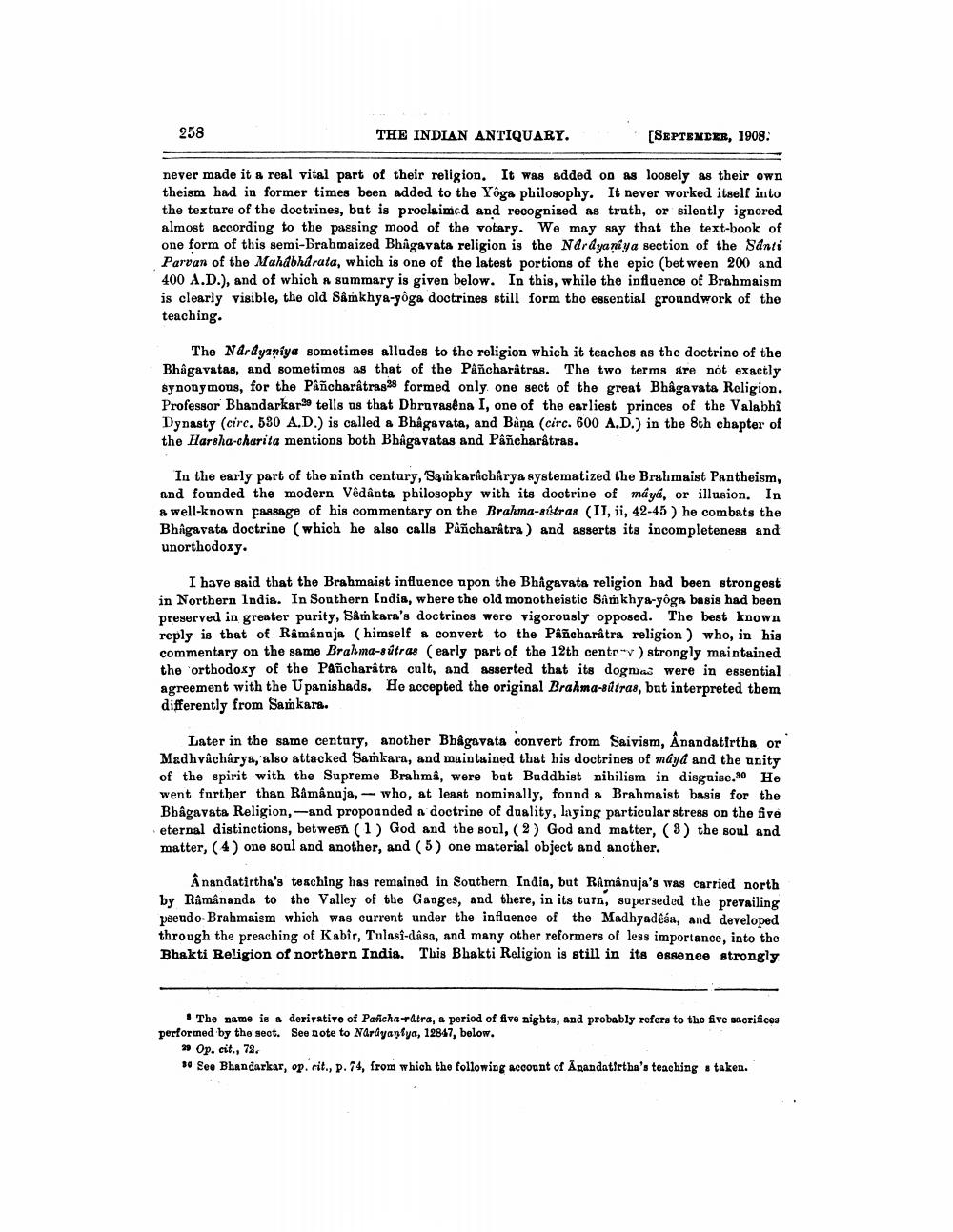________________
258
THE INDIAN ANTIQUARY.
[SEPTEMCER, 1908.
never made it a real vital part of their religion. It was added on as loosely as their own theism had in former times been added to the Yoga philosophy. It never worked itself into the texture of the doctrines, but is proclaimed and recognized as truth, or silently ignored almost according to the passing mood of the votary. We may say that the text-book of one form of this semi-Brahmaized Bhagavata religion is the Narayaniya section of the Santi Parvan of the Mahabharata, which is one of the latest portions of the epic (between 200 and 400 A.D.), and of which a summary is given below. In this, while the influence of Brahmaism is clearly visible, the old Sâmkhya-yoga doctrines still form the essential groundwork of the teaching.
The Narayaniya sometimes alludes to the religion which it teaches as the doctrine of the Bhagavatas, and sometimes as that of the Pañcharâtras. The two terms are not exactly synonymous, for the Pâñcharâtrass formed only one sect of the great Bhagavata Religion. Professor Bhandarkar tells us that Dhruvasena I, one of the earliest princes of the Valabhi Dynasty (circ. 530 A.D.) is called a Bhagavata, and Bana (circ. 600 A.D.) in the 8th chapter of the Harsha-charita mentions both Bhagavatas and Pâñcharâtras.
In the early part of the ninth century, Samkaracharya systematized the Brahmaist Pantheism, and founded the modern Vêdânta philosophy with its doctrine of máyá, or illusion. In a well-known passage of his commentary on the Brahma-sutras (II, ii, 42-45) he combats the Bhagavata doctrine (which he also calls Pâñcharâtra) and asserts its incompleteness and unorthodoxy.
I have said that the Brahmaist influence upon the Bhagavata religion had been strongest in Northern India. In Southern India, where the old monotheistic Sâm khya-yoga basis had been preserved in greater purity, Sâm kara's doctrines were vigorously opposed. The best known reply is that of Râmânuja (himself a convert to the Pâñcharâtra religion) who, in his commentary on the same Brahma-sutras (early part of the 12th centrov) strongly maintained the orthodoxy of the Pañcharâtra cult, and asserted that its dogmas were in essential agreement with the Upanishads. He accepted the original Brahma-sutras, but interpreted them differently from Samkara.
Later in the same century, another Bhagavata convert from Saivism, Ânandatirtha or Madhvacharya, also attacked Samkara, and maintained that his doctrines of maya and the unity of the spirit with the Supreme Brahmâ, were bat Buddhist nihilism in disguise.30 He went further than Râmânuja, who, at least nominally, found a Brahmaist basis for the Bhagavata Religion, -and propounded a doctrine of duality, laying particular stress on the five eternal distinctions, between (1) God and the soul, (2) God and matter, (3) the soul and matter, (4) one soul and another, and (5) one material object and another.
Anandatirtha's teaching has remained in Southern India, but Râmânuja's was carried north by Râmânanda to the Valley of the Ganges, and there, in its turn, superseded the prevailing pseudo-Brahmaism which was current under the influence of the Madhyadêsa, and developed through the preaching of Kabir, Tulasî-dâsa, and many other reformers of less importance, into the Bhakti Religion of northern India. This Bhakti Religion is still in its essence strongly
The name is a derivative of Pañcha-ratra, a period of five nights, and probably refers to the five sacrifices performed by the sect. See note to Narayaniya, 12847, below.
29 Op. cit., 72.
30 See Bhandarkar, op. cit., p. 74, from which the following account of Anandatirtha's teaching s taken.




